Situated nearly 70 kilometers away from Da Nang and belonging to the territory of Duy Phu commune, Duy Xuyen district, Quang Nam province, My Son Sanctuary is a cluster of Champa temples with extremely unique architecture. Forgotten for centuries, this vestige of an extinct Asian civilization had not been discovered until 1885. In 1999, it was recognized by the UNESCO as a world cultural heritage site. If you love exploring and learning about ancient cultures, this place is worth checking out.
Visiting My Son relics
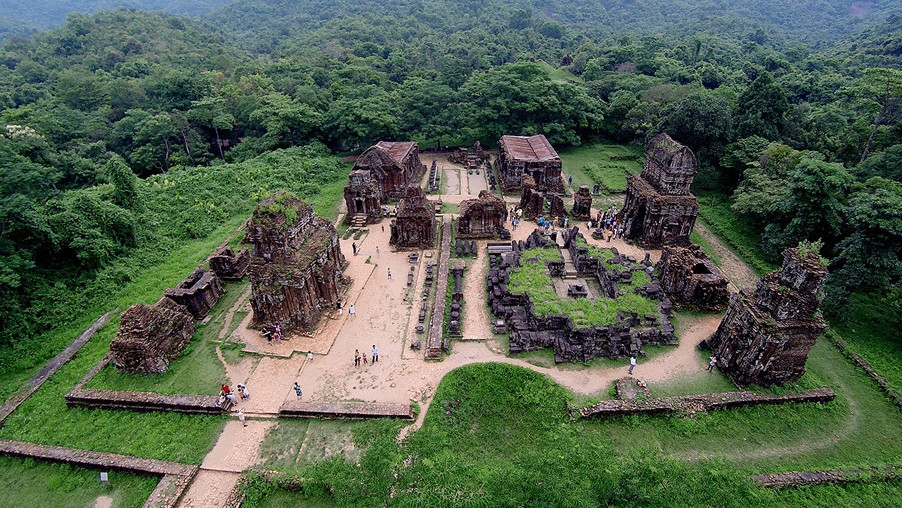
The mystery My Son
My Son, the religious and political capital of the Champa Kingdom, is a complex of Hindu temples. It is located in Duy Phu commune, Duy Xuyen district, Quang Nam province, about 20 kilometers west of Tra Kieu, 45 kilometers west of Hoi An city, 68 kilometers southwest of, and 145 kilometers south of ancient capital of Hue. This complex stretches in a valley with a diameter of about 2km, surrounded by hills and mountains. This used to be a worship place as well as burial site of the kings and royal princes of the ancient Champa dynasties. In 1999, My Son relic site of Vietnam was recognized by the UNESCO as a World Cultural Heritage.
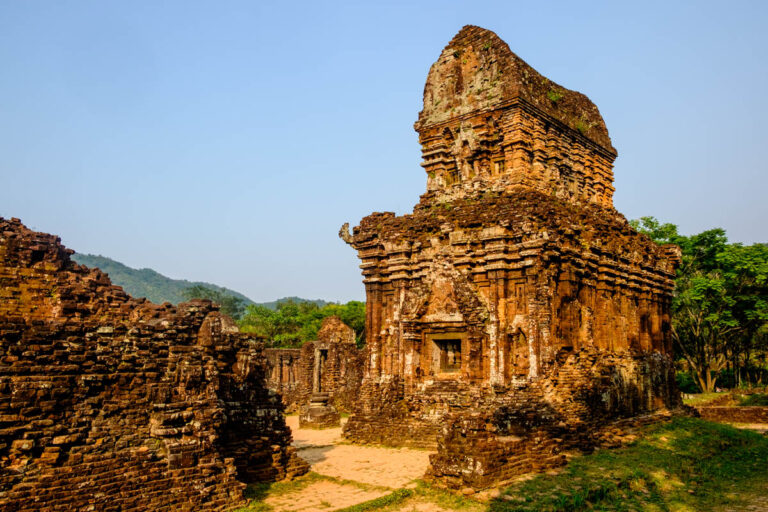
To start the journey to discover the most mysterious sanctuary in Vietnam, you just need a motorbike or a car. If you are in Hoi An, start at Hung Vuong Street and go straight along National Highway 1A for about 50km. Normally, it only takes backpackers nearly 2 hours to arrive. The price of renting a motorbike is about 150,000 – 200,000 VND/day. Be mindful that you should fill up the gas tank and check the weather forecast before going.
Bearing the mark of a long-standing history
My Son Sanctuary was constructed between the 4th and the 14th century. The first temple was dedicated to King Bhadravarman who founded the first king lineage of Amaravati at the end of the 4th century, assimilated with the god Siva and became a cult of god – king and royal ancestors. This is a cluster of many temples of the Champa kingdom, located in a small valley with a diameter of about 2 km, surrounded by mountains and hills.
Featured architecture in My Son
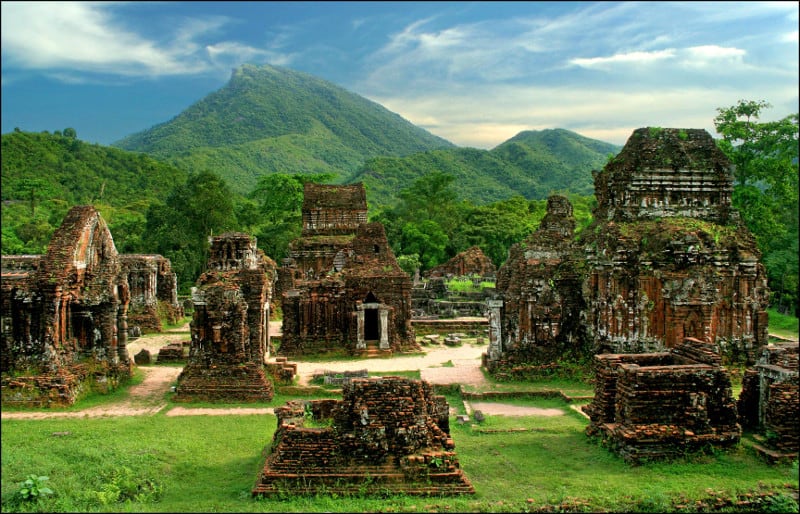
It is a historical complex of more than 70 temples and towers with many architectural styles and sculptures representing for each historical period of the Champa kingdom. There remain 6 styles of architecture: ancient style, Hoa Lai, Dong Duong, My Son, PoNagar style and the style of Binh Dinh people. Most of the architectural works and sculptures in My Son were influenced by Hinduism.
Sculptural techniques of the Cham people rarely appear in other regions’ art. The towers all have pyramidal structure – symbol of the divine Meru and the residence of the Hindu gods. The gates usually head east to receive sunlight. The outside of the wall was decorated with S-shaped leaf patterns that connect with each other. The decorations are sandstone sculptures of Makara (mythical beast with sharped fangs and long trunk), Apsara dancer, lion, elephant, Garuda bird and prayer statues. Up to now, there is no study pointing out the adhesive used to stick the decorations on the constructions. Cham sculpture art highlights the intense vitality of people with their inner spirit – joy, calm and anguish at different moments. Each historical period has its own mark with different architectural features. My Son Sanctuary in Quang Nam is not only a masterpiece of Champa architecture but also of Southeast Asian culture.
The over view of My Son relics
The whole sanctuary consists of two hills, facing each other in the East – West direction and right at the intersection of a stream. The stream branches are the natural boundary dividing this place into four areas A, B, C, D. This division matches feng shui elements while avoiding the situation of tearing apart the overall architecture. The center of the relics is the main tower (Kalan) and many small sub-towers surrounding. The main tower has two doors in the east-west direction. At each door, there are 8 steps to go up and some arches. On each arch, there is a miniature tower. According to the remaining documents, this is the tallest tower in My Son with a height of 24 meters. The bottom of the tower is square with 10 meters long each side. In the tower, Cham people worshiped a large set of Linga – Yoni (now there is only one Yoni stone pedestal). The upper part of the tower has 3 floors getting smaller towards the tower top that was made of sandstone. On each floor, there is a fake door with a human figure standing under the arch. The two fake doors are two overlapping arches, decorated with very sophisticated patterns.
Time and wars had devastated the relics. But the ruins still remain a mysterious beauty with the unique architecture of Champa people. It raises the curiosity of both domestic and foreign tourists to come and explore. Children under 15 years old are free to visit (including the fee for tram ride to the monument and watch the cultural performance). The local guides are very friendly, enthusiastic and hospitable. They have national pride, so the information they give you will be very different from what provided by a group guide.
My Son Sanctuary is not only impressing with its own architecture, but also imbued with the culture of the Cham people with gentle and flexible Champa dances. The main ritual dance is the sacred dance towards the gods in the temples and towers. The image of female Cham dancers wearing candles, water, fruits, betel nut and areca on their heads to celebrate is very lively. Or the stage dance – Apsara – with its flexibility and smoothness highlights the beauty and curves of Cham women. These dances easily touch the hearts of tourists coming to My Son. In addition, this place also holds other unique artistic activities such as folk performing arts, fire-biting dances, ritual dances, water team dances, etc. Surely, visitors will not be disappointed here. This place is also a destination that attracts photographers who love the mystery and uniqueness of the relics as well as backpackers who love to learn and explore or stop by to take some souvenir photos with friends and relatives.
In the nearby area of My Son ruins, there are a few places you should visit such as Tra Kieu Church, Our Lady of Tra Kieu, Sa Huynh Culture Museum – Champa.
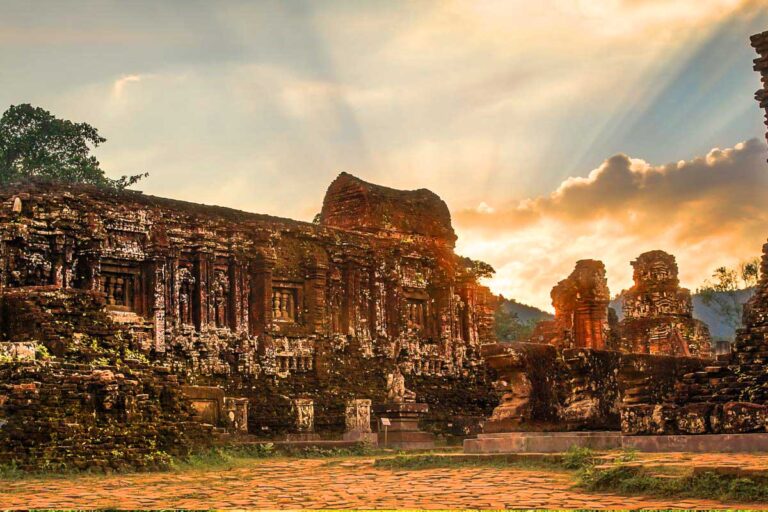
Breathtaking sunset
Additionally, do not forget to enjoy delicious, nutritious and dirt-cheap specialties here: banh bot loc, Tam Ky chicken rice, Quang Nam green eel porridge, banh to, Quang noodles… with family and friends. You will definitely want to come back. Take my words for that.
Ticket price
For foreign tourists: 150.000 VND/person (including entry and service fees)
For domestic tourist: 100.000 VND/person (including entry and service fees)
Kate festival
If you come on the occasion that the festival is taking place, your trip will become much more enjoyable. At the beginning of the festival, Cham religious dignitaries perform rituals to pray for peace at the tower according to an immemorial custom. Following that, traditional rituals such as vestments, palanquin processions, water and Kate processions, etc. are held. There are also Cham ethnic musical instrument performances and Cham dance performances by local artists, etc. The festival is an opportunity for local people and both domestic and foreign tourists to gain more knowledge about this place as well as contribute to maintaining and protecting artistic values art of the ancient Cham culture.
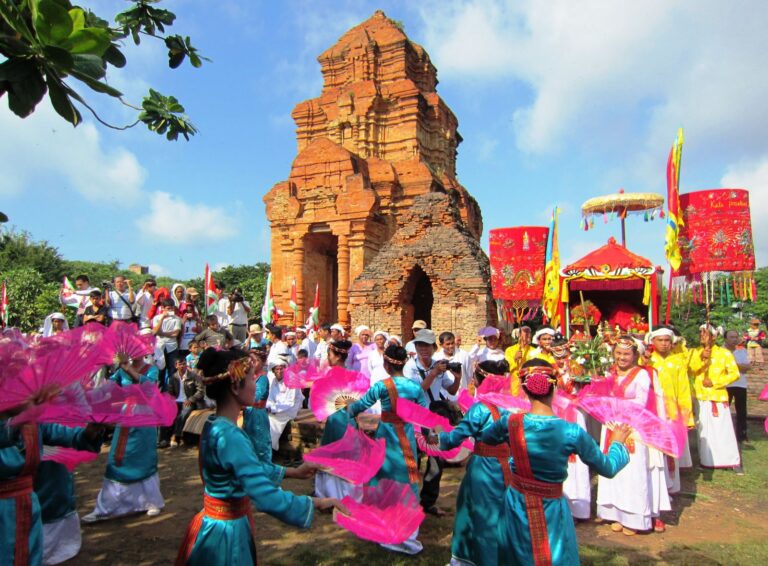
Kate festival
The thousand-year-old road
The road was discovered by an Indian expert during the excavation and restoration of the K tower in the core area of My Son complex. Up to 8m wide, the road is led by 2 parallel walls buried nearly 1m in the ground. As written in some documents, this was the first gate and only used by kings, members of the royal family and the most noble dignitaries of Champa to go to the central temples and towers to make offerings to the gods and organize ceremonies. After excavating, the experts were amazed at the magnificence of this road with its ingenious leading wall system, specific materials such as terracotta and special adhesive. Thanks to this interesting discovery, the long-standing historical, architectural, cultural and artistic values that the ancients have created in the whole complex were enriched.
Magical Apsara dance
Inspired by Apsara stone statues (Yang Naitri dancer) in bas-reliefs or sandstone statues, flexible Apsara dance shows the perfect natural beauty of women. This smooth dance is performed at mass art festivals and even professional stages. In Kate festival, the magical dance – “soul of the rock” dance will allure you and make you lost in the ancient Cham culture with the images of girls with curved bamboo shoots, seductive breasts and curves in bright and sparkling costumes. In the sound of Paranung drums and Sarainai trumpets, the dance is even more beautiful and flexible that will glamor audiences.



Comments